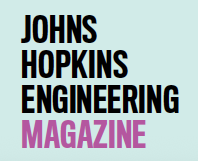An army of sustainability-minded scientists is currently working on ways to remove the leading greenhouse gas, carbon dioxide, from the air. “Humans generate those emissions. We should be able to remove them,” says one of those scientists, Hadas Elazar-Mittelman, Engr ’23 (MSE), a doctoral student in the Department of Materials Science and Engineering, who has made carbon sequestration the focus of her research at the Ralph O’Connor Sustainable Energy Institute (ROSEI).
Noting that a remarkable 8% of all carbon dioxide in the atmosphere is produced during the manufacturing of a single product, cement, Elazar-Mittelman has taken on that particular source as her cause. Many carbon sequestration scientists are working to turn captured carbon dioxide into other valuable products, like alcohols, which can be used as sustainable fuels. Unfortunately, with fuels, the carbon simply returns to the skies when the fuel is burned. That is, the carbon is sequestered only temporarily.
Elazar-Mittelman is instead turning harvested CO2 into solid carbon that can be used in new cement—sequestering it permanently. Her recent work is focused on scaling up a promising CO2 conversion reaction that uses magnesium as the reducing agent.
“The reaction between CO2 and magnesium vapor yields a carbon-ceramic nanocomposite with high hardness and compression strength that can be blended into new cement,” she explains. “This way, the captured CO2 can be permanently stored as a solid.”
So far, the reaction has only been conducted on small scales because the heat generated is so intense. On the other hand, Elazar-Mittleman says, “all that heat can be used in cement-making, so I think we can potentially make carbon-negative cement.”
This work requires a deft blend of cross-disciplinary engineering skills, evident in the fact that Elazar-Mittelman has two doctoral advisers, Jonah Erlebacher, professor of materials science and engineering, and Michael Tsapatsis, Bloomberg Distinguished Professor of chemical and biomolecular engineering.
Elazar-Mittelman is now working on ways to do the CO2 conversion at larger scales and studying how this carbon product can be integrated into cement. “This technology will only make sense if we can bring down the cost to compete in a sector defined by high volumes and razor-thin margins,” she says.
— ANDREW MYERS


